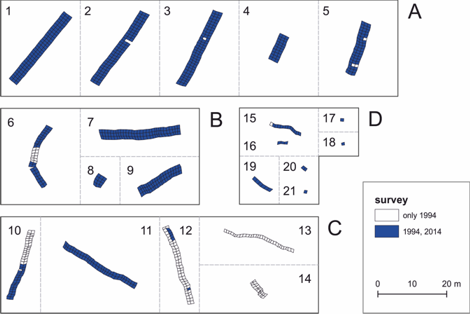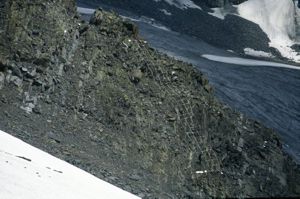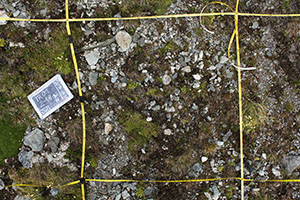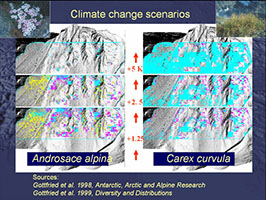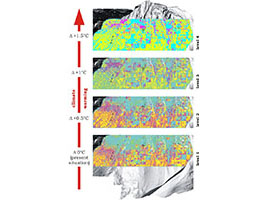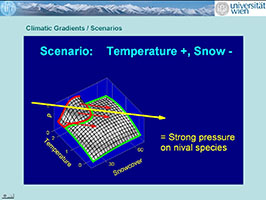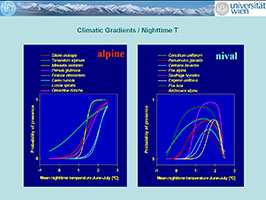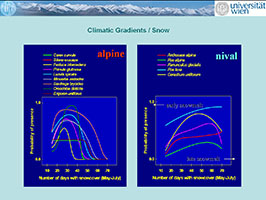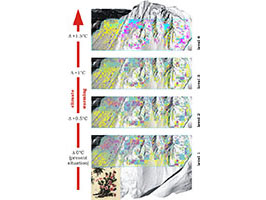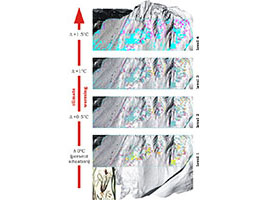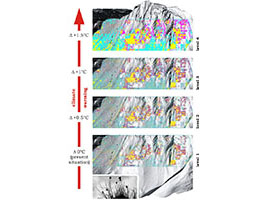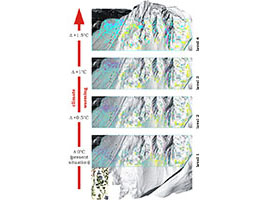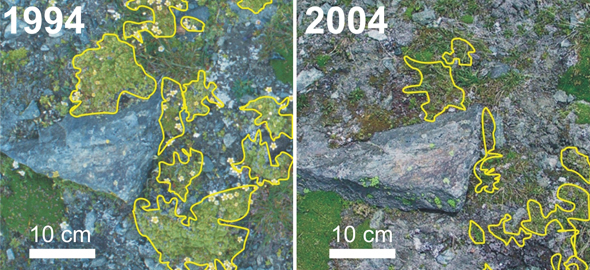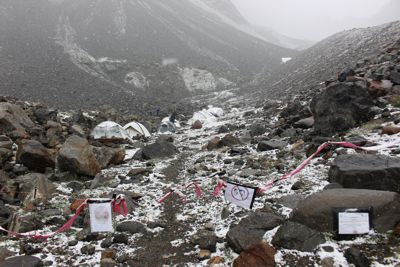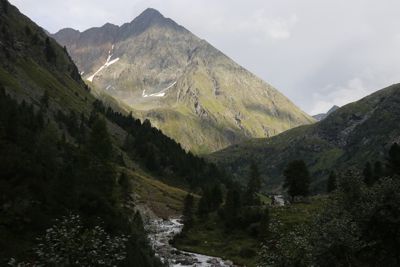The GLORIA Master Site Schrankogel, Stubaier Alpen, Tyrol, Austria
LTER site of the LTSER Platform Tyrolean Alps.General information, baseline 1994 to 2012
The first GLORIA Master Site dates back to 1994, when an extensive
setting of permanent plots, arranged in transects across the
alpine-nival ecotone was established at Mount Schrankogel in the central
high Alps of Tyrol. These permanent plots were setup in response to
evidences on upward shifts of alpine plants on high peaks of the Alps,
reinvestigated in 1992 and 1993 (GOTTFRIED et al. 1994; GRABHERR et al.
1994, 2001; PAULI et al. 2001).
Field work for the site setup in 1994, the resurvey 2004, site maintenance and additional studies and data
analyses (2005-2011) have been supported by the Austrian Academy of Sciences through the international
Geosphere-Biosphere and the UNESCO-MaB programmes, of the Austrian Federal Ministry of Science and Research
(BMWF) as well as of Agriculture, Forestry, Environment and Water Management (BMLFUW), the Government of
Tyrol, the Swiss MAVA Foundation and the EU FP6 integrated project ALARM - Assessing Large-Scale Risks for
Biodiversity with Tested Methods, No. GOCE-CT-2003-506675) and by the University of Vienna.
Permanent plots of 1x1m were arranged in transects on the mountain's
south-western slope, at its
southern,
south-eastern, and
eastern ridges.
Positions of the corner points of each quadrat were accurately surveyed
by using a tachymetre and photographs were made from each plot.
Percentage cover of all vascular plant species and total percentage cover of bryophytes
and lichens as well as the cover of abiotic surface components were
recorded. Further, a Digital Elevation Model of 1x1m-resolution, covering the entire study
area, was generated.
Between 1994 and 2011, a number of additional studies were added to the
extensive basic dataset of Schrankogel:
Besides an area-wide vegetation mapping
(ABRATE 1998; DULLINGER 1998) and a description of subnival to nival
plant assemblages (PAULI et al. 1999), model studies on vegetation
distribution and
patterns in relation to the macro- and micro-relief and micro-climate
were conducted (GOTTFRIED et al. 1998; GOTTFRIED et al. 1999, 2002).
Based on these studies, scenarios of future distribution patterns of keystone species were developed. Scenarios for the currently common nival species Androsace alpina, for example, suggested a drastic area losses due to climate warming.
Further, the influence of domestic and wild-living ungulates (ERTL et al. 2002; HUELBER et al. 2005), nitrogen gradients (HUBER et al. 2007), permafrost patterns (HAEBERLI et al., unpubl.), flowering phenology and photoperiodism of alpine and nival vascular plants (KELLER & KÖRNER 2003; HUELBER et al. 2006), as well as patterns of bryophytes (HOHENWALLNER et al. 2002) were investigated. One of the most important additional dataset for the analysis vegetation development at the Schrankogel Master Site are temperature time-series, measured at around 40 positions distributed over the mountain's southern slope system since 1997.
What were the most obvious changes at Schrankogel's alpine-nival ecotone between 1994 and 2004? A
re-investigation
of a representative one third of the Schrankogel permanent plots showed the following (PAULI et al.
2007):
(1) the vascular plant species richness has
significantly increased in the 1x1m-quadrats; the observed magnitude
of this increase was consistent with earlier studies from high summits of the Alps
(GRABHERR et al. 1994; PAULI et al. 1996; GRABHERR et al. 2001; BAHN & KÖRNER 2003; WALTHER et al.
2005);
(2) the species numbers have increased significantly more in plots which were formerly described as open
subnival
and nival vegetation (PAULI et al. 1999) compared to plots with alpine grassland vegetation;
(3) the increase in species richness was mostly due to species which were already present in the elevation
zone
and
not due to invasion of species from lower altitudes; this 'filling process' rather than upward-migration is
explained by the fairly homogenuous grassland belt which may act as a barrier to invasion by lower-elevation
species;
similar effects were observed on Piz Linard in Switzerland (PAULI et al. 2001, 2003).
(4) some alpine species and alpine to subnival pioneer species of have increased their cover, whereas all
‚true
nival'
showed a decline. See (PAULI et al. 2007) below for details.
The observed changes on Mount Schrankogel confirmed data-based model scenarios on climate-induced impacts on high-mountain plants (GOTTFRIED et al. 1998; GOTTFRIED et al. 1999, 2002) and showed - for the first time in the European Alps - signals of declines of the most cold-adapted species.
As a cooperation with climatologists of the University of Vienna (Research Platform "Mountain Limits") we recently analysed the relationship between the alpine nival ecotone and the summer snowline. Results showed that these to ecological/climatological lines coincide strongly and that both lines moved upwards during the last decades (GOTTFRIED et al. 2011).
References
Hohenwallner, D.; Zechmeister, H. & Grabherr, G. (2002) Bryophyten und ihre Eignung als Indikatoren für den Klimawandel im Hochgebirge - erste Ergebnisse. In: Bericht über das 10. Österreichische Botanikerteffen. BAL-Gumpenstein, Irdning, pp 19-21.
Abrate, S. (1998) Vegetationskarte des Schrankogel, Stubaier Alpen. In. Universität Wien, p 105.
Dullinger, S. (1998) Vegetation des Schrankogel, Stubaier Alpen. In: Diplomarbeit Universität Wien. Universität Wien, p 189.
Period 2013-2020
Project Schrankogel 20 years
Schrankogel 20 years: Warming in the cold: vascular plant and soil biota responses in the high Alps during
the past 20 years Funded by the Austrian Climate Research Programme (GZ B368633 ACRP6; KR13AC6K11076);
project duration 2014-2017.
Project leadership: GLORIA Coordination (ÖAW-IGF & BOKU-ZgWN); partner: Institute of Microbiology of the
University of Innsbruck and Department of Integrative Biology and Biodiversity Research, BOKU Vienna.
Research questions and the corresponding key results (1)
- Did the species richness and species composition in alpine to nival habitats change during the past decades?
- Was the magnitude and velocity of these changes higher during the past decade than in the preceding one?
- Can the observed compositional change in alpine to nival vegetation be attributed to recent climate change?
- Vascular plant species richness increased over the 20-years period, but slightly slower during the recent decade, owing to a slight drop of species colonisations and a concurrent sharp increase in species disappearances from the permanent plots.
- Composition of plant communities showed a directional transformation towards more warm-demanding (i.e. thermophilisation) and drought-tolerant vegetation. Both processes were significantly stronger during the recent decade
- High-elevation species (subnival-nival) experienced the strongest decrease in cover and presence in the plots.
- Colonising species were predominantly those centred in treeline to alpine habitats.
- Species pseudo-turnover among pairs of observers was significantly lower than turnover over time on Schrankogel. The same applies to deviations in species cover estimates among observers compared to cover changes over time.
Related publications
Research questions and the corresponding key results (2)
- Do evolutionally and functionally differing soil microbial organism groups show differing distribution patterns from the alpine grassland zone to the upper elevational limits of their occurrence?
- Microbial activities and abundance declined with elevation, but reached considerable levels even in the subnival zone, where vegetated soil occurred. This, surprisingly, included methane-producing Archaea, occurring abundantly in cold and aerobic soils. Related publications
Related publications
Research questions and the corresponding key results (3)
- Are abundance and activity patterns of soil microorganisms, and abundance and diversity patterns of soil mesofauna and surface-dwelling arthropods related to the elevational distribution patterns of high mountain vegetation
- Collembola abundance diversity patterns strongly deviated from that of vascular plants along an alpin-nival gradient, whereas patterns of other organism groups were more similar to that of plants, with spiders and beetles showing the highest congruence.
- Oribatida took an intermediate position, but a species so far only known from the Arctic has been discovered on Schrankogel.
Related publications
Main conclusions
Our findings not only confirm model projections of plant species declines and changes in species composition, but also show an acceleration in species disappearances, thermophilisation and the shift towards more drought-tolerant vegetation. Consistently, declines on the species level were stronger in high-elevation species, where substitute habitats towards higher altitudes are limited, whereas expanding species from lower elevations are expected to exert competition pressure on cold-adapted specialist plants.
The study of microbiota along a gradient from high alpine (2700m) to nival environments represent a pioneer work in high-elevation microbiology and showed surprisingly high activity levels of methan-producing microorganism in cold alpine soils.
Our findings may provide a first indication to which extent other organism groups concurrently come under pressure with vascular plants, given that their abundance and species diversity patterns are strongly linked to the occurrence of vegetation, which especially applies to surface-dwelling spiders and beetles, whereas Collembola represent a notable exception in occurring even at unvegetated high-elevation habitats. They, therefore, may also elucidate to which extent changes of plant patterns can be used as a proxy for other organism groups which are more difficult to sample and monitor.
Final report (in German with English summary).
Period 2020-
Project MicroClim
MicroClim: A micro-scale perspective on alpine floras under climate change. Linking observations and models
to improve our understanding of the future of European high mountain plants
ERC Advanced Grant project (number 883669); project duration: 2021-2025.
Project leadership: Dept. of Botany and Biodiversity Research of the University of Vienna; partner: GLORIA
Coordination (ÖAW-IGF & BOKU-DIB) and Institute of Geography of the University of Innsbruck; collaborators
form BOKU-DIB and GLORIA-Europe.
Commencing in January 2021,
MicroClim
links so far separated research strands of monitoring, experimental
approaches and predictive modelling in order to assess thermal micro-niches of alpine plant species in the
context of projected biodiversity losses through ongoing climate change.
- The GLORIA and LTER site Schrankogel is core location of MicroClim, where five out of 10 projects tasks conducted ( project structure of MicroClim): microscale maps, plant community data, vital rates of alpine plant species, Schrankogel resurvey (a core task of the GLORIA Coordination), and dynamic micro-scale modelling.
- The task of interaction experiments is mainly conducted at the LTER site Obergurgl.
- The further four tasks involve the GLORIA-Europe sites with baseline data from 2001/2002.
- Schrankogel webcams established in the frame of MicroClim.

